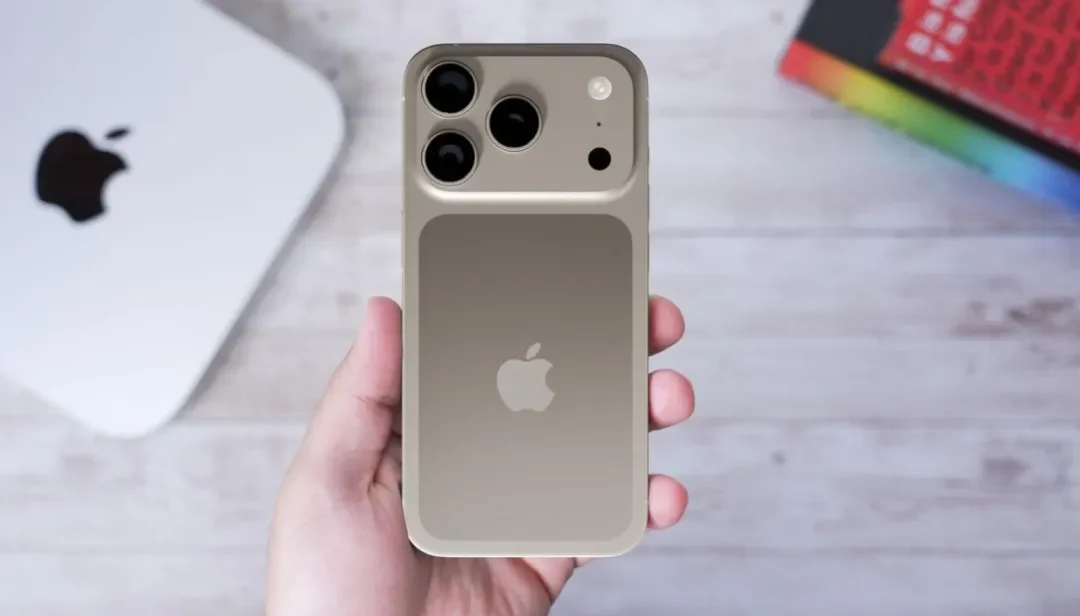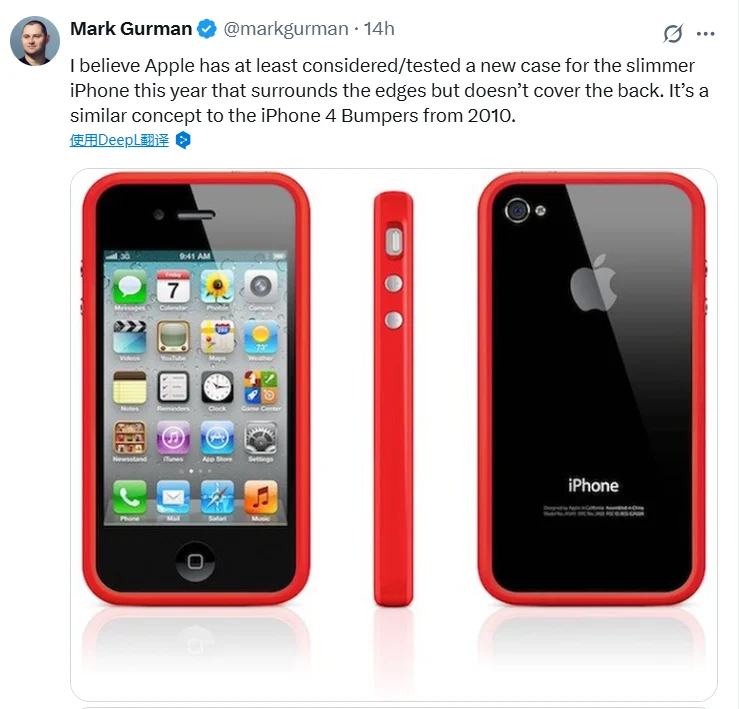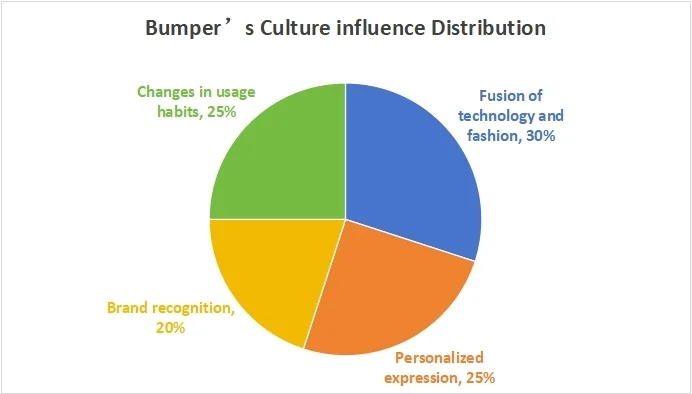contact Boss
Don’t rush to close it, talk to our boss directly, you will get a surprise.



1900+ Users
Completed User Services

As the release date of iPhone 17 Pro draws closer, more and more information about iPhone 17 is revealed through channels.
Ten hours ago, Bloomberg’s Mark Gurman tweeted on X, believing that Apple is considering restarting the “border-style” bumper case design used for the iPhone 4 in 2010 for this year’s iPhone 17 series.

The bezel-style design first appeared on the iPhone 4 in 2010, and Apple gave it away free of charge. Mark Gurman reports that Apple is considering this accessory, and Appleinnsider suggests it may be for the iPhone 17 Air, the thinnest model yet. This type of case features a design that only covers the phone’s bezels, leaving the back completely bare and free of transparent plastic.
This phone case provides basic protection while allowing users to see both sides at the same time, protecting both the front and back of the phone. On the one hand, it can preserve the visual beauty, and on the other hand, it can avoid the yellowing problem of traditional transparent cases due to aging.
In terms of protection mechanism, the front and back edges of the Bumper phone case are slightly higher than the body panel by a few millimeters, which can prevent the screen or back cover from directly contacting hard particles on the table when placed flat, reducing the risk of scratches.
As a product launched 15 years ago, why did Apple bring back the “edge-style” bumper case design this time? What is the significance of this?
As a user who has used Apple products since the iPhone 3, Kevin. Kenny, editor-in-chief of PickOnes, believes that the iPhone 4’s “border-style” bumper case design, although not the first of its kind, has left a unique mark on the history of mobile phone cases thanks to its deep integration with the product itself, its precise fit with user needs, and its influence on industry design logic.
Kevin. Kenny believes that Apple’s relaunch of the “border-style” bumper case design is mainly due to the following reasons:
Before the iPhone 4, phone cases were primarily provided by third-party manufacturers. Most were generic accessories whose core function was passive protection, often disconnected from the phone’s design. The iPhone 4 Bumper, however, achieved deep synergy between the phone and the case—it was no longer a simple protective tool, but a complementary solution designed by Apple specifically for the iPhone 4’s unique characteristics and user needs.
The bumper’s design language is highly consistent with iPhone 4, using high-quality materials and fine craftsmanship, making it look like a natural extension of iPhone 4 rather than an afterthought.
This design concept of “customizing for specific models and aligning with product pain points” has since been widely adopted by the industry. The bumper design had the following significant impacts on the iPhone 4 design:
The bumper design, for the first time, clearly articulated the core principle of “lightweight protection”: prioritizing the phone’s aesthetic design while specifically addressing high-frequency risk points. This “focusing on essentials while eliminating redundancies” design precisely addressed the needs of certain users.
The “lightweight protection” concept of the iPhone 4 Bumper has had a profound impact on the entire protective case industry, promoting the transformation of protective case design from “full protection” to “selective protection”.

Through the above chart, we can clearly summarize the following very meaningful content:
Before Bumper, phone case personalization was limited to simple variations in color and pattern, and was primarily based on low-cost third-party products. However, Bumper, through Apple’s brand endorsement and refined design, elevated phone cases to the status of a “fashionable consumer electronics item,” endowing them with status symbols.
The introduction of the bumper design not only changed the design direction of protective cases but also profoundly influenced consumers’ perception and consumption concepts of mobile phone accessories.
Looking back over the past 15 years, we’ve discovered that the Bumper design has become more than just a product; it’s become a cultural icon, reflecting and shaping people’s attitudes and habits regarding technology. Bumper’s design and marketing have successfully transformed protective cases from a functional accessory into a status symbol and fashion item.
Bumper’s cultural influence is reflected in many aspects, including the integration of technology and fashion, new ways of personalized expression, external manifestations of brand identity, and changes in the use habits of technology products.

Bumper has changed the way people approach technology, from “protecting it as much as possible” to “selectively displaying it.” This shift in usage habits reflects a shift in people’s attitudes toward technology, from instrumental use to emotional interaction.
Objectively speaking, the “border-style protective case” was not invented by Apple, but the core value of Bumper lies in: through its deep integration with the iPhone 4, it redefined the role of the “mobile phone case” – from a “passive protective accessory” to a core component that “collaborates with product design, supplements functional defects, and meets personalized needs.”
From a product design perspective, Bumper pioneered a new concept of “lightweight protection,” successfully striking a balance between protective performance and design appeal, driving the shift in protective case design from “full-coverage protection” to “selective protection.”
This design philosophy continues to influence the development of mainstream protective cases today.
From a market perspective, the Bumper product is not only a successful example of Apple’s accessory strategy, but also has had a profound impact on the entire protective case industry.
It has increased the market value of accessories, promoted the upgrading and diversification of the accessories market, and transformed accessories from marginal products to an integral part of the core product ecosystem.
From a cultural perspective, Bumper successfully transformed protective cases from functional accessories into a hybrid product that combines fashion and functionality, becoming a symbol of the fusion of technology and fashion. It has changed people’s attitudes towards product protection, stimulated the demand for personalized expression, and strengthened brand identity.
Bumper’s design logic (model-specific, lightweight protection, and fashionable expression) still influences the research and development of mainstream protective cases. It can be called a “milestone product” in the transformation of mobile phone protective cases from “practical tools” to “design items.”
Fashion is a cycle. After 15 years of development and iteration, we are back on the path of pursuing personalized expression and brand identity.